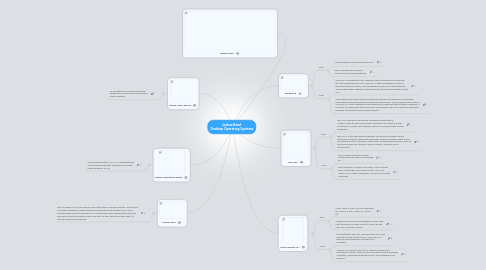
1. Market Share
2. Define: Operating System
2.1. An operating system, or "OS," is software that communicates with the hardware and allows other programs to run.
3. Define: Open Source
3.1. Of or relating to or being computer software for which the source code is freely available.
4. Define: RAM
4.1. RAM is made up of small memory chips that form a memory module. Every time you open a program, it gets loaded from the hard drive into the RAM. This is because reading data from the RAM is much faster than reading data from the hard drive. Running programs from the RAM of the computer allows them to function without any lag time.
5. Windows 8
5.1. Pros
5.1.1. Most programs are already made for it.
5.1.2. Easy navigation and easy to customize and change settings.
5.2. Cons
5.2.1. "From an IT perspective, the changes made to Windows 8 could end up costing businesses a lot of money. To take advantage of many of the new features offered, new hardware will need to be purchased to support the higher graphics demand and touch-sensitive aspects of the OS."
5.2.2. "Windows 8 does away with the traditional task bar and features a completely new ribbon-based interface for first-party applications. Those using recent versions of Office, or using a tablet running Windows 8 might feel right at home. However, a majority of people will need some form of training to get up to speed on the many changes and enhancements being offered."
6. Mac OSX
6.1. Pros
6.1.1. Mac OS is the only commercial operating system that is custom-made to work with Apple’s hardware. This gives it a level of efficiency, power, and stability, which is most important for the workplace.
6.1.2. Mac OS X is still the operating system of choice for graphic artists, designers and most others who work with visual and audio media. It also synchronizes user information well across multiple Apple devices, such as the iPhone and iPad, making it easily usable in a mobile office environment.
6.2. Cons
6.2.1. Price: Apple computers simply cost much more than your average PC.
6.2.2. Only available on Apple computers: If you already have a computer, you cannot install MAC on it unless it's an Apple. Otherwise, you must buy a new computer.
7. Linux Unbuntu 12.1
7.1. Pros
7.1.1. Price: Linux is free. You can download it, install it, use it, modify it... All for 0$.
7.1.2. Although being more vulnerable to viruses than Mac (because it is open source), Linux still has very, very, very few viruses.
7.2. Cons
7.2.1. Compatibility: Like Mac, representing only a few percents of the market share, Linux does not have as many programs and games as Windows.
7.2.2. Vendors: You won't find a lot of vendors selling Linux computers. Usually, you'll just end up having to buy Windows computer, reformatting the hard drive, and installing Linux yourself.
